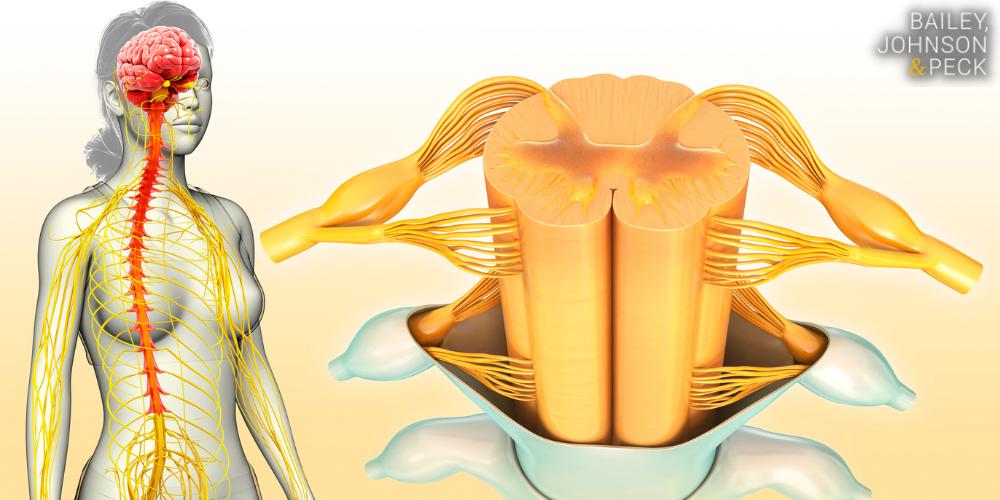
SOUND COUNSEL. STRAIGHT TALK. SENSIBLE SOLUTIONS.
Albany Paralysis Lawyer
A paralysis injury is considered catastrophic because it’s a life-changing injury that requires a long recovery period and – in many cases – round-the-clock care once the person is medically stable. Spinal cord injuries caused by serious accidents such as car accidents, workplace accidents, and medical malpractice incidents most commonly lead to paralysis. On top of the immense pain and suffering that most paralysis victims endure, many also have to worry about thousands of dollars of debt from medical bills and lost wages. And that’s why so many people with paralysis injuries seek financial recovery through personal injury claims. The good news is that an Albany paralysis lawyer at Bailey, Johnson & Peck can help with this financial recovery.
If you have suffered a spinal cord injury, traumatic brain injury (TBI), or any other type of catastrophic injury due to a severe accident, you may have grounds to take legal action. Every single personal injury attorney at our law firm has the skill and experience to help you obtain justice and a fair settlement for your paralysis claim. In fact, we have been helping accident victims recover fair settlements for more than 40 years. Call 518-456-0082 to schedule a free case evaluation with an Albany paralysis lawyer today.

What is Paralysis?
Paralysis is severe damage to the central nervous system which causes a person to lose motor and sensory function in certain parts of the body. A spinal cord injury usually causes partial or complete paralysis. Neurons are responsible for sending messages to the brain and spinal cord so that we can move and feel touch, temperature, pain, etc. When a serious injury (such as spinal cord damage) interrupts these neurons, the victim will no longer have motor and sensory function in parts of the body or the whole body.
How Many Americans Suffer From Paralysis?
Paralysis affects approximately 5.4 million Americans according to a 2013 report.
Types of Spinal Cord Injuries
Victims can suffer from either a complete spinal cord injury or an incomplete spinal cord injury. The type of spinal cord injury depends on what kind of accident occurred and what section of the spinal cord suffered damage.
- Complete Spinal Cord Injury: This type of spinal injury is characterized by a complete loss of movement and sensation below the injury location. This means if someone suffers a cervical spinal cord injury from a serious accident, they will lose complete motor and sensory function below the cervical region (AKA the neck).
- Incomplete Spinal Cord Injury: This type of spinal injury is characterized by some motor and sensory function below the injury location. An incomplete spinal injury is also known as partial paralysis. So we can use the same example as above: a person suffers a cervical spinal cord injury during a traumatic accident. But because they’re only partially paralyzed, they may be able to feel some sensations in their upper extremities. They may even be able to move their hands or fingers. It all depends on the person, the accident, and the injury.
According to the National Spinal Cord Injury Statistical Center (NSCISC), most spinal cord injuries are incomplete injuries, with approximately 65% of injured victims suffering from incomplete tetraplegia or paraplegia.

Types of Paralysis
Similarly to the types of spinal cord injuries, there are also many types of paralysis that people can suffer from depending on the type of accident, the location of the injury, and the limbs affected. Listed below are the 4 main types of paralysis injuries:
- Monoplegia: People with monoplegia generally cannot move one limb.
- Hemiplegia: People with hemiplegia generally can’t move their limbs on only one side of the body.
- Paraplegia: People with paraplegia generally can’t move or feel anything below the waist.
- Quadriplegia, or complete paralysis, refers to those who can’t move or feel anything below the neck. Generally all four limbs are paralyzed. It’s very common for quadriplegia patients to also have paralyzed pelvic organs.
There are also other types of paralysis that simply describe the way the muscles are affected from the injury. There is flaccid paralysis, which is characterized by floppy, shrinking, and sagging muscles. And then there is spastic paralysis, which is characterized by stiff and jerky muscles. It’s very common for cerebral palsy patients to have spastic paralysis.
Common Causes of Paralysis
Most of the time, paralysis occurs from some kind of traumatic injury or accident. Our Albany personal injury lawyers often see paralysis cases caused by:
- Motor vehicle accidents such as car accidents, truck accidents, bicycle accidents, and pedestrian accidents
- Medical negligence incidents such as surgical errors, epidural errors, or chiropractic errors
- Workplace injuries
- Swimming pool accidents, like diving into the shallow end of the pool
- Violent physical assaults
- Slip and fall accidents
- Trampoline accidents (which are very common child injuries)
- Sports accidents
- Birth injuries such as cerebral palsy
- Locked-in syndrome, which is a rare neurological disorder
- Strokes
- Autoimmune diseases such as multiple sclerosis (MS) and Guillain-Barre syndrome
According to a 2013 study, car accidents have caused the largest percentage (31%) of paralytic injuries since 2005. That’s why our Albany paralysis injury attorneys are so passionate about fighting for the justice of those who have suffered permanent paralysis in a motor vehicle accident. We can help you recover compensation for medical costs, lost wages, pain and suffering, and more in a paralysis lawsuit.
Complications Associated With Spinal Injuries
Spinal cord injuries obviously lead to partial or full paralysis, but they can also lead to a wide variety of other conditions such as:
- Cardiopulmonary issues and/or difficulty breathing
- Difficulty swallowing (dysphagia)
- Psychological issues such as depression, anxiety, PTSD, panic attacks, suicidal thoughts, hopelessness, etc.
- Tingling in paralyzed regions of the body
- Chronic pain
- Sexual dysfunction
- Blood pressure issues
- Poor circulation which can lead to deep vein thrombosis or blood clots
- Bedsores from sitting/laying in one position for most of the day
- Loss of bladder and bowel control

Can Paralysis Be Reversed?
Paralysis injuries are irreversible. It is still possible, depending on the type and severity of the injury, for patients to regain some mobility and independence through physical therapy and medical devices. But for the most part, the spinal cord damage cannot be undone.
Treatment for Paralysis
Treatment for paralysis injuries heavily depends on what caused the paralysis to begin with. If a car accident (or other traumatic accident) caused the paralysis injury, then the victim will likely have to undergo spinal surgery and physical therapy in order to become medically stable again. Paralysis victims also have to take a wide variety of medications to control symptoms like chronic pain, tingling, blood pressure changes, and poor circulation.
Paralysis caused by neurological disorders, such as locked-in syndrome, cannot be cured through treatment. The main goal is to keep the patient as comfortable as possible and prevent other health complications through medication and physical therapy.
Once paralysis victims become medically stable, they will often learn how to use a variety of adaptive medical devices to become as independent as possible. For example, paralysis victims may need prosthetic and orthotic devices, voice activated technology, and adaptive equipment to help them eat, speak, and go to the bathroom.
Proving Negligence in a Catastrophic Injury Claim
Just like in other types of personal injury cases, proving negligence is crucial for a successful paralysis injury lawsuit. Albany paralysis lawyers at Bailey, Johnson & Peck can help accident victims prove the 4 elements of negligence listed below.
- Duty of Care: Everyone has a specific duty of care to keep each other safe. For example, all drivers have a duty of care to drive sober and carefully in order to keep themselves – and other drivers – safe.
- Duty Dereliction: The at-fault party breached this duty of care through negligent actions or inactions.
- Direct Cause: The at-fault party’s negligence directly caused the victim’s paralysis injury.
- Damages: The paralysis victim suffered a variety of damages that they should recover compensation for.
It’s difficult to prove negligence in a personal injury claim without experienced legal counsel. That’s why it’s so crucial to hire an Albany paralysis lawyer at Bailey, Johnson & Peck. Our paralysis attorneys can help victims prove these elements of negligence through medical records, witness statements, police reports, surveillance camera footage, pictures, and more.
Damages for Paralysis
An Albany paralysis lawyer at Bailey, Johnson & Peck can help paralyzed victims recover compensation for the following types of damages:
- Past and future medical expenses
- Past and future rehabilitative expenses
- Expenses for necessary medical devices
- Caretaking expenses
- Lost wages
- Loss of earning capacity
- Physical pain and suffering
- Mental anguish
- Mental health counseling bills
- Loss of consortium
- Loss of enjoyment of life

Call an Albany Paralysis Lawyer at Bailey, Johnson & Peck Today
If you have suffered paralysis due to someone else’s negligence, you have grounds to recover compensation through a personal injury claim. The legal team at Bailey, Johnson & Peck has more than 40 years of experience in helping spinal cord injury victims obtain justice for their suffering. We know that know amount of money can ever undo the physical and emotional trauma from an accident, but it can help you have the best quality of life possible while you’re healing and learning to be independent again. Call our law firm at 518-456-0082 to schedule a free consultation today.Practice Areas
Helping Injury Victims
Put Their Lives Back Together
Schedule a Consultation
Our attorneys have extensive experience in personal injury law, including car accidents, slip-and-fall accidents, catastrophic injuries and wrongful death. If you have questions about insurance coverage and how to get the financial compensation you need, contact us today to see how we can help.
We have represented many clients on both sides of personal injury and insurance disputes. Let us use our depth of knowledge and experience to help you and your family get the medical care and financial compensation you need and deserve.


